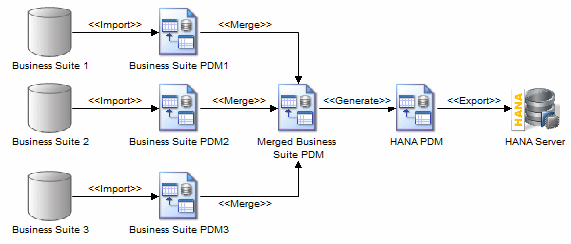PowerDesigner can help you prepare a HANA table structure to allow consolidated reporting on one or more SAP Business Suite installations.

- Create a PDM for each SAP Business Suite installation, and import the logical tables that you want to define warehouse reporting on (see Importing an SAP Business Suite Data Dictionary).
- Analyze and purify your models, deleting components, packages, tables, and
columns that are not of interest to your reporting project.Note: You should not edit the properties of Business Suite objects (except for the Comment field or Notes tab) or create new objects, in order to ensure the integrity of the metadata that will be generated to the HANA schema.
- Select a model to act as the core warehouse model, and then select Tools > Merge Models and merge the other models into it one after the other to create
a superset of all the components, packages, tables, and columns that you want to
generate to HANA.For detailed information about merging models, see Core Features Guide > Modeling with PowerDesigner > Comparing and Merging Models.
- Select Tools > SAP Business Suite > Generate HANA Physical Data Model.
- Select whether you want to Preserve package hierarchy, which is the default mode, and will recreate the Business Suite component and package structure to the HANA PDM. Note that this structure does not represent HANA packages. Deselecting this option will suppress the creation of these packages and will generate all your tables to the new PDM root. In both cases, your tables will all be exported to the HANA catalog.
- Click OK to begin the generation.PowerDesigner generates a new PDM targeting the HANA DBMS.Note: PowerDesigner generates the Business Suite component and package structure to the HANA PDM.
- Export your tables to your HANA server (see Exporting Objects to the HANA Repository).Implement loading of your transactional data to your HANA warehouse using your standard ETL solution.